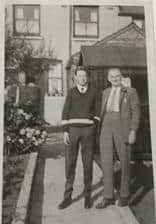Historian shares fond memories of growing up in Stocksbridge in the 1950s
and live on Freeview channel 276
Situated in the north-west of Sheffield, it is classed as a town with a population of around 14,000.
Graham, aged 74, a passionate historian was born there just after World War Two.
Advertisement
Hide AdAdvertisement
Hide AdHe said: “My parents and I lived on Sitwell Avenue and my grandparents moved to the house next door to ours.”


His father Jack Branston served in the second world war as an air ambulance paramedic and also a keen historian. He wrote The History of Stocksbridge back in the 1980’s.
His son Graham also developed a keen interest in history.
Graham went to primary school in Stocksbridge, then onto Penistone Grammar school. He continued his education, going on to read economic history and geography at Leeds University.
He went on to study further completing a research degree. He followed that with a career as a HR manager and also lectured in management.


Advertisement
Hide AdAdvertisement
Hide AdNow living in Leeds, Graham has published several books and booklets about aspects of local history in, which has enabled him to donate the profits to local charities and organisations.
He is currently working on an autobiography about his childhood growing up in a ‘garden village’.
He said: “It is not just about my childhood, it is also a history of the garden village and surrounding areas, which were built to provide homes for the rapidly increasing population who had come to work in the steel industry of which at the time was Fox Steel.”
Graham hopes his booklet will generate some funds for Stocksbridge and District History Society. Its chairman Mr D Pindar (full name needed) has contributed some photos from his collection.
Advertisement
Hide AdAdvertisement
Hide AdThe garden village movement was the brainchild of Sir Ebenezer Howard OBE - an urban developer from the 1800s.
He saw garden villages as a solution to overcrowded cities, self sufficient and self contained.
Letchworth and Welwyn Garden City were two of such developments in the south of England.
At the beginning of the 20th century the site of the garden village was shown as farmland on the Ordnance Survey Map 1908.
Advertisement
Hide AdAdvertisement
Hide AdThe garden village ;Oxley Park’ development started just before World War One from land gifted from Thomas ‘Jammy’ Oxley, so nicknamed because he owned a fruit farm in the area.
It is also said he donated an apple tree to every house in the village.
At this time steel works and population was expanding at a rapid pace.This growth was not halted by the start of World War One. The population in Stocksbridge increased from 7,086 1911 to 9,062 in 1921.
Soon after the war, provision of gas and water soon followed. An interesting feature of the village was the provision of gardens to every home, plus the village had allotments on three sides.
Advertisement
Hide AdAdvertisement
Hide AdGraham's father took advantage of this - a keen gardener showed vegetables at the annual garden show.
Graham remembers quite an idyllic childhood.
He said: “Oxley Park was great for games and sports with a small play area for swings, seesaw and sand pit for the small kids.”
There was also Oxley Park football club, which Graham played on briefly.
“The pitch was extremely muddy and the pitch sloped side to side not goal to goal,” he said.
Advertisement
Hide AdAdvertisement
Hide Ad“There was also a welfare committee that organised a summer gala,trips to the seaside and panto in the winter - great fun!”
As the steel works grew, vast amounts of earth were moved to create a base for a new huge furnace. The excavated earth was used to create a three tiers of additional parkland.
Graham hopes to complete his book in the near future and would welcome photos and comments, from residents of Oxley Park and Stocksbridge.